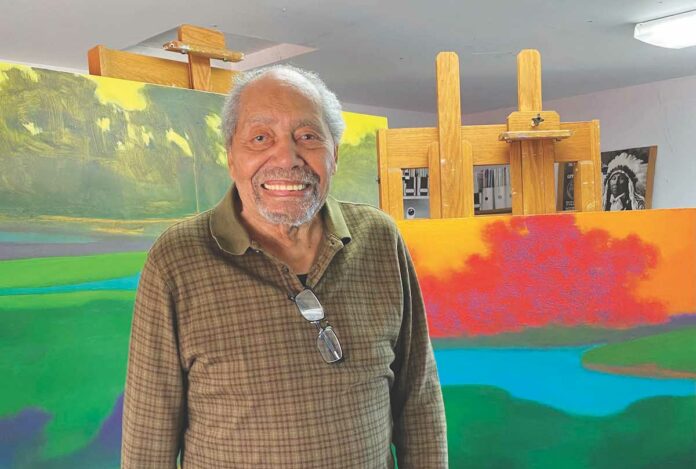Richard Mayhew’s vibrant landscape paintings possess a dreamlike familiarity. The viewer feels as if they are inside the works, instigating an emotional response of intimacy.
The Sonoma Valley Museum of Art’s current rare exhibition of Mayhew’s artwork not only embodies this intimacy but celebrates American art, culture, and history.
“I paint more from the inside out, with a sensitivity to nature while living the experience of the painting,” Mayhew explains. This sensitivity has been honed over decades of painting and extends into his life.
It’s extraordinary to find an artist still working at almost 100 years old and who also actively mentors younger artists. Mayhew’s work came of age during the civil rights movement, and he is the last surviving member of Spiral, a think-tank collective formed in New York City in 1963 of Black artists who were interested in creating a cultural response to the civil rights movement.
Co-curators Shelby Graham, the former Senson Gallery director at UC Santa Cruz, and Kajahl, a professional artist with galleries in Chicago and Los Angeles who Mayhew has mentored for many years, have together crafted an exhibition showcasing the painter’s most important work.
“It is an honor to co-curate this exhibit,” says Kajahl. “I met Richard Mayhew when I was beginning my artistic journey, and his mentorship and guidance were instrumental. He suggested that I study abroad and that I move to New York City, both of which opened up my artistic opportunities. Richard also challenged me to push the boundaries of traditional art forms, and to do so by exploring and trusting my creative inner sensibility.”
Part of the exhibition highlights the significance of Mayhew’s time with Spiral, which met from 1963-1966. As an artists’ group, Spiral advocated for social change through the involvement of the cultural community. The group’s aim was also practical; they met to discuss how to develop their artistic careers in the current social context and place their work into galleries and museums during a time when it was more difficult for Black artists to find recognition.
While Spiral considered the social and political issues of the time, the member artists’ work itself wasn’t always political.
“Though Richard Mayhew was an active participant in Spiral, his art is not grounded in current events,” Graham explains. “Many people have asked how he could paint beautiful scenes in a time of turmoil. His response was, and is, to consciously generate calm and stillness in his work. He has remained true to his pursuit of transcendence through an emotional encounter with nature in the landscapes he creates.”
Indeed, the show devotes an entire wall to the workings of color theory, and how color affects one’s perceptions, a main focal point of Mayhew’s work.
“I encourage people to look deeper beyond the landscape; it’s really about color theory and emotions,” Graham says. “For example: What does love look like? He paints the emotion in his paintings. He’s inside the painting. It’s like a memory.”
Graham suggests looking specifically at color to pull the most out of the experience.
“Look for color relationships and how he plays with warm/hot colors that typically advance but might be used in the background to create a strong visual sensation juxtaposed with a cool color in the foreground. Look for signs of color theory, optics and music when you look at his work,” says Graham.
The co-curators brainstormed on many titles until they came up with “Inner Terrain” to speak about Mayhew’s sensitivity to the illusion of landscape and memory.
Graham says that the vivid landscapes often feel so familiar to viewers, that it’s common for them to think they recognize a place Mayhew has painted. But they aren’t particular places; they are all imagined—different elements pulled in with the use of color to evoke particular moods or emotions.
“He often says painting is a state of mind and that landscape is an illusion. Unlike plein air painters, Mayhew paints from memory,” Graham says. “He calls his paintings moodscapes and talks about creative consciousness.”
The show of two dozen landscape paintings is an unusual opportunity to see this much of Mayhew’s work together. His paintings are part of the permanent collections of numerous public institutions, including the Art Institute of Chicago; Los Angeles County Museum of Art; Metropolitan Museum of Art, New York; and the San Francisco Museum of Modern Art, among many others.
Mayhew was born in Amityville, New York, in 1924 and currently lives and works in Soquel, California. He’s a professor emeritus at Pennsylvania State University, having previously taught at numerous institutions, including Hunter College, Smith College, the Art Students League, Pratt Institute and the Brooklyn Museum Art School. He also studied in Italy and is among the youngest members ever elected to the National Academy of Design.
Graham and Mayhew became acquainted in 2004 when she was gallery director at University of California Santa Cruz art gallery. He’d periodically pop over and update her about his work, and they became friends over the years.
“Once you see this exhibition, you will see landscapes in a different light as you drive around Sonoma County,” says Graham. “You will start to imagine Mayhew’s brilliant landscapes everywhere you look.”
Exhibition Reception:
A reception for the exhibition goes from 5 to 7pm, Saturday, Sept. 23. The event is free for Sonoma Valley Museum of Art members, and $10 for non-members. Pre-registration is required to attend this event. A curator’s talk also featuring Richard Mayhew begins at 2pm, Sunday, Sept. 24, and is $10 SVMA members and $12 non-members. SVMA is located at 551 Broadway, Sonoma. svma.org.
PQ
It’s extraordinary to find an artist still working at almost 100 years old and who also actively mentors younger artists.











